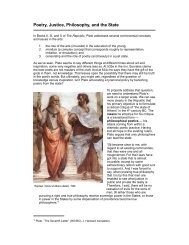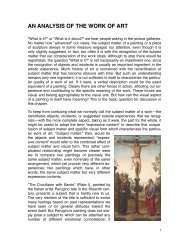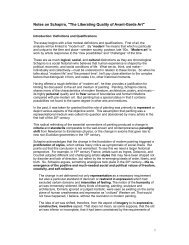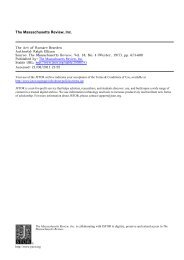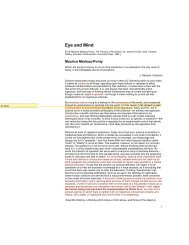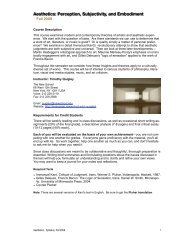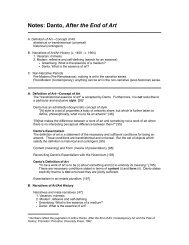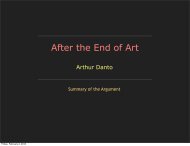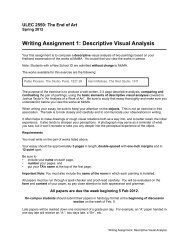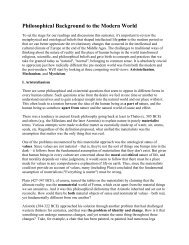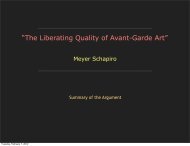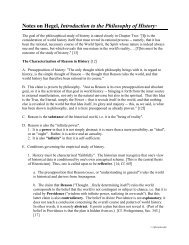Notes on Heidegger, "The Question Concerning Technology"
Notes on Heidegger, "The Question Concerning Technology"
Notes on Heidegger, "The Question Concerning Technology"
- No tags were found...
Create successful ePaper yourself
Turn your PDF publications into a flip-book with our unique Google optimized e-Paper software.
Interpreting Aristotle's Four Causes—Four Ways of Being Resp<strong>on</strong>sibleC<strong>on</strong>trary to the comm<strong>on</strong> interpretati<strong>on</strong> of Aristotle’s four causes in instrumental terms,<strong>Heidegger</strong> claims the material, formal, final, and efficient causes are the ways in which a thingis held resp<strong>on</strong>sible or indebted. To understand what <strong>Heidegger</strong> has in mind here, we need tofocus <strong>on</strong> suggestive examples of making and the c<strong>on</strong>cepts he develops to give us a pretechnologicalunderstanding of the process.We’ll start with the example of a marble sculpture of a discus thrower. In <strong>Heidegger</strong>’s terms, thestatue is “indebted” to the material (marble), the form (discus thrower), and the goal(memorializing a heroic athlete). <strong>The</strong> sculptor, as efficient cause, gathers together the "aspectsof indebtedness"—matter, form, and goal—and "brings forth" (poiēsis) the sculpture. Thus, thebringing or "bursting forth" happens through the artist. This distinguishes it from the bringingforth in nature (physis) of an object. In the latter case, it has the bringing forth in itself. But it’simportant to note that the activity of the artist does not take place apart from the othercomp<strong>on</strong>ents or causes gathered by the artist’s activity, i.e. how the work is brought forth. [9-12]Now what is this bringing forth? How does it happen in nature and in art? <strong>Heidegger</strong> says, “<strong>The</strong>four ways of being resp<strong>on</strong>sible bring something into appearance. <strong>The</strong>y let it come forth intopresencing [An-wesen]. <strong>The</strong>y set it free to that place and so start it <strong>on</strong> its way, namely, into itscomplete arrival.” [9] <strong>The</strong> bringing-forth “is a unified process, ‘a single leading-forth to which [eachof the causes] is indebted’”. 1Aristotle’s Four Causes• Material — matter (hyle) is resp<strong>on</strong>sible [7]• Formal — form (morphe) is resp<strong>on</strong>sible [7]• Final — goal (telos) is resp<strong>on</strong>sible [8]• Efficient — maker is resp<strong>on</strong>sible for gathering together the other three [8]According to <strong>Heidegger</strong>, all four are interwoven and “co-resp<strong>on</strong>sible” for what is made.Albert Borgmann’s example of the wheelwright is helpful in getting the phenomena in fr<strong>on</strong>t of us. 2• Material — wood [bottom of 44]• Formal — wag<strong>on</strong>; the form brought forth from the wood [45]• Final — purpose linked to the particular wood and shape of the wag<strong>on</strong> [45]• Efficient — wheelwright works respectfully with nature (“human to nature”) [44]Borgmann c<strong>on</strong>trasts the wheelwright’s wag<strong>on</strong> with a technological device — a watch — to showthat instrumental means and ends in technological producti<strong>on</strong>, in which the product — the what— is the <strong>on</strong>ly real c<strong>on</strong>cern, are not overriding or determining in the traditi<strong>on</strong>al mode of revealingand producti<strong>on</strong>.<strong>The</strong> bringing-forth is also part of an unc<strong>on</strong>cealing. "Bringing-forth comes to pass <strong>on</strong>ly insofar assomething c<strong>on</strong>cealed comes into unc<strong>on</strong>cealment [alētheia]." [11]But what does this have to do with the essence of technology? "Everything…[for] technology is away of revealing." [12]1William Lovitt, “A Gesprach with <strong>Heidegger</strong> <strong>on</strong> Technology”, from David I. Waddingt<strong>on</strong>, “A Field Guide to<strong>Heidegger</strong>: Understanding ‘<strong>The</strong> Questi<strong>on</strong> C<strong>on</strong>cerning Technology’”, Educati<strong>on</strong>al Philosophy and <strong>The</strong>ory, Vol.37, No. 4, (2005), 569.2Albert Borgmann, Technology and the Character of C<strong>on</strong>temporary Life, Chicago: University of ChicagoPress, 1987. This applicati<strong>on</strong> to <strong>Heidegger</strong>’s interpretati<strong>on</strong> of the four causes was developed in Sean Kelly’sseminar course <strong>on</strong> <strong>Heidegger</strong>’s late works, Harvard Univ., 22 Oct 2008.2



